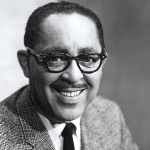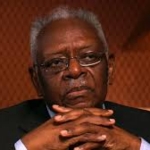Background
Sam Lacy was born on October 23, 1903, in Mystic, Connecticut, United States. He was the son of Samuel Erskine Lacy, a law firm researcher, and Rose Lacy. He grew up in Washington, District of Columbia, United States.


1971
Satchel Paige visits some members of the Hall of Fame Negro Leagues Committee in 1971 Top row: Wendell Smith, Judy Johnson, Satchel Paige, Sam Lacy, Monte Irvin. Bottom Row: Joe Reichler, Frank Forbes, Eddie Gottlieb, Roy Campanella. Photo by the National Baseball Hall of Fame Library.
1960
Portrait of former Afro American Newspapers sports reporter Sam Lacy, 1960. Photo by Afro American Newspapers
1961
The seventh President of Morgan State University Martin David Jenkins, Olympian and Civil Rights symbol Wilma Rudolph, and former Afro American Newspapers sports reporter Sam Lacy shaking hands, 1961. Photo by Afro American Newspapers
1971
Satchel Paige visits some members of the Hall of Fame Negro Leagues Committee in 1971 Top row: Wendell Smith, Judy Johnson, Satchel Paige, Sam Lacy, Monte Irvin. Bottom Row: Joe Reichler, Frank Forbes, Eddie Gottlieb, Roy Campanella. Photo by the National Baseball Hall of Fame Library.
1986
John H Murphy III and Sam Lacy reading a book, 1986. Photo by Afro American Newspapers
1990
Baltimore, Maryland, United States
Sam Lacy working in an office at the headquarters of the Afro American Newspapers, Baltimore, Maryland, 1990. Photo by Afro American Newspapers
2000
Sam Lacy and politician and Maryland congressional representative Elijah Cummings during a building dedication ceremony, October 10, 2000. Photo by Afro American Newspapers
1400 1st St NW, Washington, DC 20001, United States
Sam Lacy graduated from Armstrong Technical High School (now Friendship Armstrong Academy).
2400 6th St NW, Washington, DC 20059, United States
In 1923 Sam Lacy received a Bachelor of Arts degree from Howard University.













(His dream was to play professional baseball. Instead, Sam...)
His dream was to play professional baseball. Instead, Sam Lacy became an outspoken advocate for equal opportunity, using words to pry open doors so athletes at all levels could realize their dreams. Fighting for Fairness is the account of sportswriter Sam Lacy’s career-long battle to lower racial barriers in sports. Lacy spearheaded integration in major league baseball, and recognition of this achievement led to his induction into the writer’s wing of the Baseball Hall of Fame on July 26, 1998. Sam Lacy’s on-the-scene accounts of sports events and insider stories about legendary sports figures are unmatched. Lacy lived with sports heroes like Jackie Robinson and Larry Doby in the segregated accommodations to which they were relegated for years, despite their outstanding performances on the playing field. This extraordinary book stands as a mirror of the progress America has made in race relations during Sam Lacy’s lifetime.
https://www.amazon.com/Fighting-Fairness-Life-Story-Sportswriter/dp/087033512X/ref=sr_1_1?dchild=1&keywords=Fighting+for+Fairness%3A+The+Life+Story+of+Hall+of+Fame+Sportswriter+Sam+Lacy&qid=1600413246&s=books&sr=1-1
1998
Sam Lacy was born on October 23, 1903, in Mystic, Connecticut, United States. He was the son of Samuel Erskine Lacy, a law firm researcher, and Rose Lacy. He grew up in Washington, District of Columbia, United States.
Sam Lacy graduated from Armstrong Technical High School (now Friendship Armstrong Academy). In 1923 he received a Bachelor of Arts degree from Howard University.
One of Sam Lacy's first jobs was selling popcorn and peanuts at the stadium. Other early work included carrying the bag for golfers such as "Long Jim" Barnes. While studying at university, he wrote part-time for the Washington Tribune as a way to earn extra money. After finishing his degree in 1923, he played semi-professional baseball for the Washington Black Sox, but his part-time writing job turned into full-time work for the Washington Tribune. He was managing editor and sports editor there from 1934 to 1939, before moving to Chicago as assistant national editor for the Chicago Defender from 1940 to 1943.
In 1943 he moved to the Baltimore Afro-American. He remained with the Afro-American as its sports editor for the remainder of his life, even after suffering a stroke in 2000. In addition to his newspaper work, Lacy was a sports commentator for WBAL-TV in Baltimore from 1968 to 1978.
During his career, Lacy wrote often about the prejudices African Americans were subjected to, and he is credited for helping baseball legend Jackie Robinson break the color barrier. Lacy frequently experienced prejudice as a black journalist: he was often snubbed by his white colleagues and was sometimes banned from entering the press box, or even from entering whites-only ballparks. He wrote regularly about the prejudice that existed in the sports industry and gradually began to shame owners into integrating their baseball and football teams.
Lacy completed his autobiography, Fighting for Fairness: The Life Story of Hall-of-Fante Sportswriter Sam Lacy in 1998.
Sam Lacy became famous for his work in convincing sports teams to hire African-Americans players. For his role in helping African Americans enter professional sports, Lacy was honored many times, receiving such honors as the Sports Illustrated Lifetime Achievement Award in 1989, the 1991 Lifetime Achievement Award from the National Association of Black Americans, the 1997 Red Smith Award from the Associated Press Sports Editors, and induction into the writers’ wing of the Baseball Hall of Fame in 1998. In 2003 he was also presented the Frederick Douglass Award from the University System of Maryland.
(His dream was to play professional baseball. Instead, Sam...)
1998Throughout his career, Sam Lacy fought to give minority athletes equal opportunities and pay in the professional sports world.
Sam Lacy was a member of the Baseball Writers' Association of America.
In 1927 Sam Lacy married Roberta Robinson. They had a son, Samuel Howe Lacy. In 1952 the couple divorced. In 1953 he married Barbara Robinson. They had a daughter, Michaelyn Lacy Harris. In 1969 his wife died.


